Effects of Nonverticality on Steel Framing Systems--Implications for Design
DOI:
https://doi.org/10.62913/engj.v45i1.924Keywords:
Analysis, Columns and compression members, Stability and BracingAbstract
The first section of the paper describes the types of initial imperfections typically considered in planar frame analysis and their effect on members and framing systems. This is followed by a discussion of how the effects of imperfections are treated in the AISC Specification. A parametric study is presented in which the sensitivity of framing systems to imperfection effects is investigated with respect to a number of parameters including slenderness ratios, leaning load levels, gravity to lateral load ratios, and lateral frame stiffness, as measured by a second-order to first-order drift ratio. In addition to the sensitivity study, a number of columns and simple frames were analyzed with and without imperfections using the direct analysis approach for assessing frame stability outlined in Appendix 7 of the AISC Specification. The differences in the interaction checks for simple columns and frames are used to discuss the current limits on when imperfection effects may be neglected.

